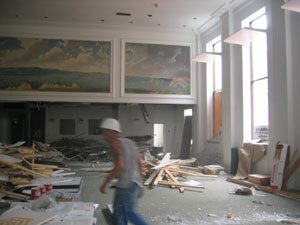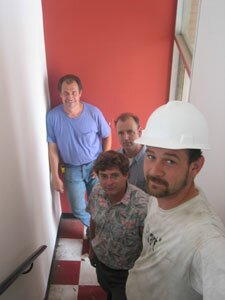ONARCHITECTURE- Uncovered: Anything possible in Boxer space
As was mentioned briefly last week, developer Oliver Kuttner is in the early stages of renovating the former Central Fidelity building (also formerly the Boxer Learning building) on the Downtown Mall. In May, Kuttner bought what he refers to as "the best building in Charlottesville" for $3.7 million. Former owner Lee Danielson had planned to build a nine-story hotel on the site, but Kuttner, bucking the trend toward Mall projects that high, says he wants to stick to two stories, gut the building, create 18,000 square feet of retail space, a bunch of condos, and wrap it all up in a jaw-dropping design.
As he said last week during a brainstorming session with his architects, Kuttner considers his last big Charlottesville development, the Terraces, located two blocks to the west, "a good building, not a great building."
Anyway, that's old news. "Now I have a second chance," he says, "so let's build a great building."
Vacant since a spring 2003 downsizing by Boxer Learning, the 20,000-foot structure stretches from the Mall to Water Street, a bank of beige brick along Second Street SE.
Like Danielson, Kuttner has been vocal about his frustration with City officials and the red tape involved in getting things built. In fact, several years ago he vowed never again to build in Charlottesville, preferring instead to focus his efforts on Lynchburg. "Everything is talked about 100 times," he complained. "By the time you're done, you've spent 10 or 20 percent of the budget on paper." Kuttner has also said that the 1999-2002 work on the Terraces was stopped 18 times by architectural and zoning department concerns.
Unlike Danielson, Kuttner has now decided to make peace with City officials and return to downtown development with a kinder, gentler approach.
"Part of my red tape complaint," Kuttner admits, "comes out of my own incompetence in dealing with red tape."
Apparently, Kuttner is also under considerable financial pressure.
"This is the deal that could sink me," he says, revealing that interest on borrowed money and other expenses rings up a $1,000 a day "carrying cost." And just recently Kuttner admitted he has obtained money to renovate the front of the building but has not yet secured funds for the back.
In another revealing move, Kuttner has decided to open up the development process to the press. Hours before his first meeting with architects on July 19, Kuttner stopped by the Hook office to suggest the paper cover the building project from beginning to end. "I want you guys to follow this from day one," he said. Given the fact that most developers– with the possible exception of Donald Trump– tend to avoid media coverage, it seemed a bold move.
Hours later, Kuttner met with project architects Gate Pratt and David Kariel and construction foreman John Haywood– with a Hook reporter looking on. In the heat and dust of the mostly demolished interior– the floor littered with spent blank shell casings from a city police training drill the day before– Kuttner laid out his vision for the space.
"I want 18,000 square feet of retail," he told his audience, "and I think I know how to do it."
Kuttner points out that the building was two buildings before the bank's renovation, and he plans to take the building back to that original configuration, but with condos on one side and retail on the other. He also wants to build so that floors can be added in the future.
As for the exterior, Kuttner acknowledges that the Board of Architectural Review is requiring him to retain the black granite façade, making it difficult to create welcoming entrances and store fronts. His idea is to build slotted entryways in place of the current windows, and to give the Second Street wall a bombed-out, crumpled appearance. "I call it the apocalyptic look," he says.
"I also love the top of the Chrysler building," he says, which makes him want to use stainless steel on the exterior.
"The façade will be made in China then assembled here," the global-marketeer explains. "I want to use the cheap China labor situation because I think it's temporary. It won't last. It's an opportunity to build something special while the labor situation in China is still good."
Kuttner describes an open courtyard in the center of the building with lots of glass and natural stone– even moss growing in corners around a series of fountains. He also visualizes a horizontal rubber-belted airport-style escalator at the entrance to whisk people into the building.
Even the old bank vault and a big tree out back have a place in Kuttner's plan. The vault, he says, will remain to become a retail space: "You could call it ‘The Vault.' Maybe it could be a jewelry store. Who knows?" Instead of cutting down the old tree on the Water Street side of the building, the nature-loving developer suggests including it within the building. "There's something nice about having an old tree," he says. "Every time a tree gets cut, my heart bleeds a bit."
Kuttner continues describing his dream in a stream-of-conscious monologue as a way to get the creative ball rolling. Indeed, his boyish enthusiasm and open-mindedness for the project are contagious. "Everything I've said can be changed," he tells Kariel and Pratt. "I can be talked into changing just about anything. You know that."
But one thing won't change: the murals near the ceiling in the bank lobby. Construction foreman Haywood says the pastoral scenes will remain. As Kuttner goes on without pause, Haywood quietly explains the logic of leaving them exposed to the dust and demolition. "We were told we would damage them more if we covered them up," he says.

Kuttner wants to save the painted murals in the old Central Fidelity building, but big changes are in "store" for the rest.
PHOTO BY DAVE MCNAIR

The players: developer Oliver Kuttner, architects David Kariel and Gate Pratt, and construction foreman John Haywood
PHOTO BY DAVE MCNAIR
#